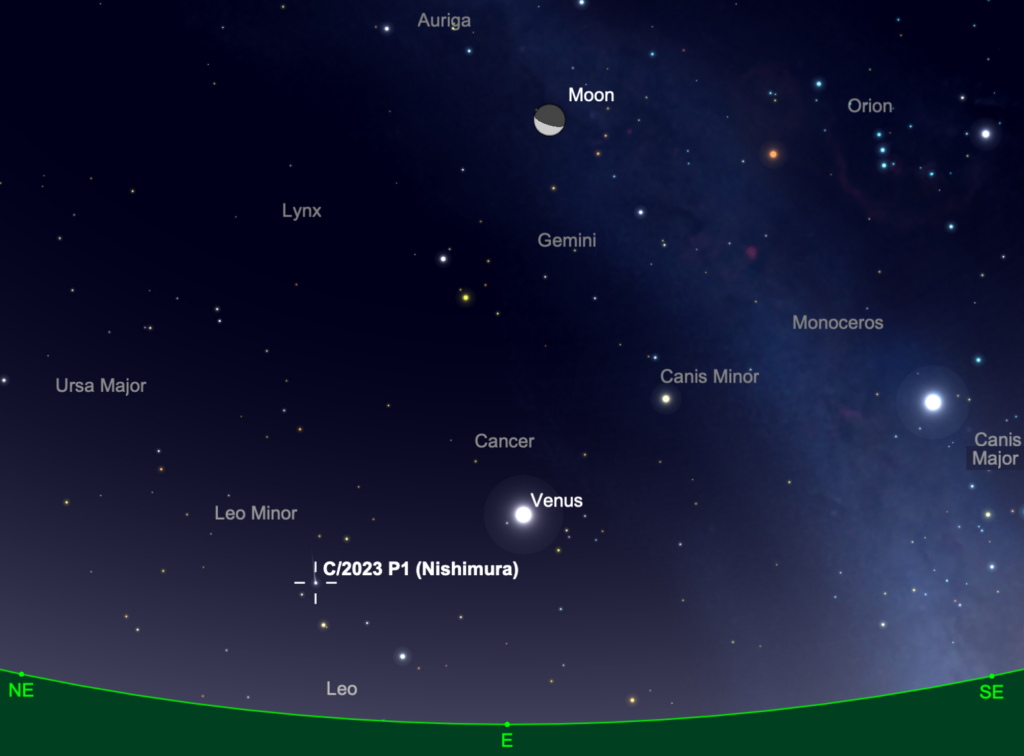Sky Report: September 4 – 10, 2023

The eastern sky 45 minutes before sunrise on September 8th showing the comet, Venus, the moon, and the locations of the constellations. Graphic created with SkySafariAstronomy.com.
A comet discovered only last month *might* become bright enough to see with the naked eye this week; in any case you should easily see it with binoculars. Named Comet Nishimura for the amateur astronomer who discovered it, the comet is approaching the sun and growing brighter. It’s difficult to predict in advance how bright it will become, and while it passes closest to the sun it could even disintegrate, but it might brighten enough to see it without optical aid later this week, and to binoculars before that. Look for it low in the predawn sky roughly 20° to the left and then lower left of Venus. Google “Comet Nishimura” for additional and more current information including daily directions on how to find it.
After about the 10th it moves too close to the sun to see it any longer, so it’s making a very brief appearance.
You may or may not see the comet but you’ll certainly see Venus, now the brilliant “morning star” to use the poetic term. Telescopically it looks like the thinnest of crescents. Venus passed between the earth and sun only a month ago but already it has swung far enough to the west (right) of the sun that it rises a full 3 hours before the sun and is well up in the east in morning twilight. Venus is in Cancer, a constellation that has no bright stars. The only reason you’ve heard of Cancer is that it’s one of the constellations of the zodiac and the sun, moon, and planets pass through it, as Venus is doing this week. (Actually Cancer is home to a pretty cluster of stars, M44 or the Beehive, which is about 10° to the upper left of Venus; check it out with binoculars after you look at the comet.)
The bright star to the upper right of Venus is Procyon in Canis Minor, the Small Dog, while Sirius – the brightest star in the sky – is farther to the right in Canis Major, the Big Dog. Orion the Hunter sits directly above Sirius while the Gemini twins sit a similar distance above Venus.
The crescent moon, in a similar phase to Venus, sits 11° from Venus on the morning of the 11th.
Turning to the evening sky, Saturn is rising in the east as the sky grows dark. It’s the brightest thing in the early night sky (other than the moon) so you can’t miss it. It’s in Aquarius, a large scraggly constellation with no bright stars to compete. Note its soft yellow color.
Jupiter rises by midnight and outshines Saturn by 28 times. Note that it’s whiter than Saturn. The light we see from each is sunlight reflected off the planet’s cloud tops, but Jupiter’s clouds reflect a greater range of colors than Saturn, so it appears white. Jupiter is brighter because it’s both closer and larger than Saturn. Our moon is in the vicinity of Jupiter on the 4th and 5th.
Stellar Vista Observatory provides portable telescopes and tripod mounted binocular kits on loan for free to residents and visitors in Kane County. Enhance your enjoyment of the night sky! To learn more, request a loan, or attend one of SVO’s free public star parties for 2023, visit https://stellarvistaobservatory.org/ or drop in to the Kane County Office of Tourism.






Comments are closed.